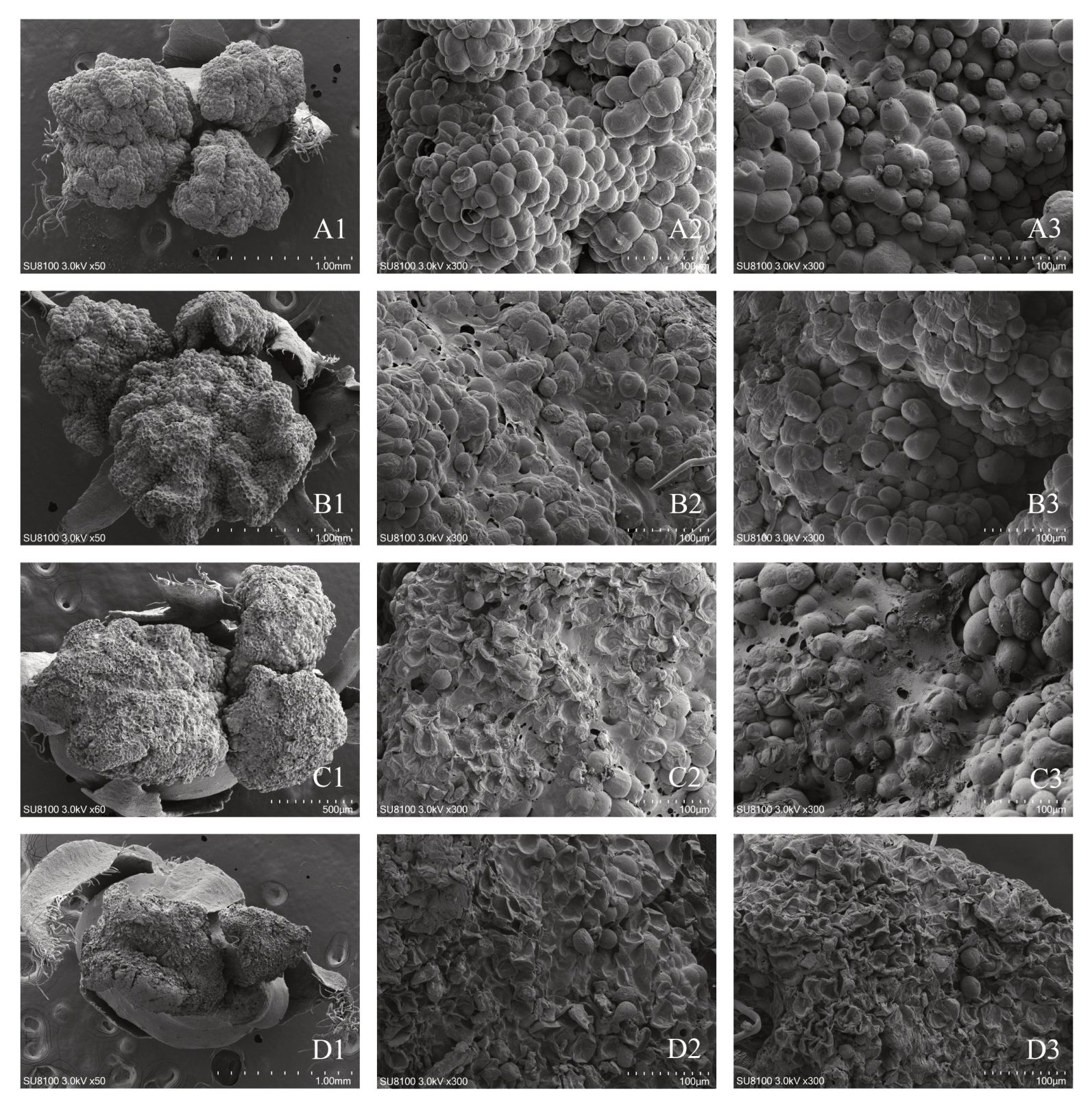良好的授粉受精是保证果树果实产量和品质的先决条件,而授粉受精与柱头状态、柱头可授性、花粉管的生长等密切相关[1]。雌花柱头会接收花粉,同时为花粉的附着和萌发提供必要的基底环境并发挥识别作用[2]。柱头之下是花柱结构,花柱为花粉管的生长提供了通道,柱头与花柱共同作用,才能保障花粉管能够顺利到达胚囊[3]。柱头可授性的强弱在很大程度上决定了植物能否成功完成授粉受精过程[4]。除此之外,植物的授粉受精还受到外部环境因素的影响[5],如遇沙尘、低温、大风、阴雨等天气,会对雌花柱头产生影响,降低柱头可授性,进而影响植物的授粉受精过程[6]。有研究显示,降尘会对植物的组织与器官造成逆境胁迫,直接影响植物的形态结构,使其发生异常改变,情况严重时,甚至还会引发畸形现象,影响植物正常的生长发育[7]。沙尘颗粒物若存在盐分含量过高以及pH值过高的情况,会致使柱头分泌物显著减少,使柱头可授性降低,进而造成花粉难以黏附在柱头表面,还会阻碍花粉向引导组织转移,那么就会对植株的授粉受精产生影响,最终使得结果率下降,果实出现小果化的现象[8]。
阿月浑子(Pistacia vera L.)又名开心果,属于漆树科(Anacardiaceae)黄连木属(Pistacia)落叶小乔木[9-10],是全球四大坚果之一,具有很高的营养价值和经济价值[11]。目前,新疆阿月浑子总种植面积约333.3 hm2[12],主要集中在南疆喀什地区。南疆盆地及周围地区是中国主要的沙尘暴源区[13],且在春、夏季节风沙灾害频发,具有突发性强、受灾范围广的特点[14]。张礼春等[15]研究表明,枣树的柱头可授性对浮尘极为敏感。陈虹等[16]研究表明,南疆早实核桃的授粉受精受到自然降尘的负作用影响,会缩短雌花花期,对雌花柱头的发育和花粉萌发产生影响,进而降低授粉受精的成功率。阿月浑子属于雌雄异株的果树[17],雌花于每年3 月底至4 月中旬生长发育[18],正值浮尘来袭之际,其受降尘影响的程度或许要比其他果树更为严重。目前只有自然降尘对枣树[15]和核桃[16]开花结果影响的研究,浮尘对南疆阿月浑子柱头结构和柱头可授性以及授粉受精过程的影响还未见报道。因此,笔者在本研究中以浮尘天气多发的喀什地区疏附县特有果树阿月浑子克尔曼(Kerman)品种为试验材料,采用人工降尘覆盖法观察柱头超微形态结构、柱头可授性以及授粉受精过程。拟解决以下3个科学问题:(1)降尘覆盖对阿月浑子雌花柱头的超微形态有何影响。(2)降尘覆盖对阿月浑子雌花柱头可授性是否有影响,如果有具体表现在哪些方面?(3)降尘覆盖后对雌花授粉受精过程与时长有何影响。以上问题的分析试图为进一步揭示降尘对果树授粉受精的影响机制提供理论依据。
1 材料和方法
1.1 试验地概况与供试材料
试验地位于新疆喀什地区疏附县阿月浑子种植资源圃园(地理坐标:N 39°21′,E 75°51′),平均海拔1300 m,地理位置位于新疆南疆,地处帕米尔高原东麓,塔里木盆地西缘。属暖温带的荒漠生物气候带,昼夜温差大,降水稀少,日照时间长,春夏季节常出现大风、沙尘暴和浮尘天气,年均气温12.4 ℃,年均降水量65 mm,年均日照2825 h,年均无霜期233 d。试验材料为阿月浑子雌株品种克尔曼(Kerman),均选择果园中心处向阳面、树势良好、胸径一致的果树雌花花序,无尘对照和降尘处理各在2 株果树上选择3 组大花序(1 组大花序中约有300 朵花)。试验于2024年4月阿月浑子花期进行。
1.2 方法
1.2.1 降尘处理与采样 在阿月浑子雌花萌动期对花序进行套袋处理(套袋材质为硫酸纸),在雌花萌动期根据南疆花期降尘量实测数据(7.7 g·m-2·d-1),设置人工模拟的降尘覆盖量0.8 mg·cm-2为中度降尘,在中度降尘基础上分别减少和增加0.5 mg·cm-2为轻度降尘(0.3 mg·cm-2)和重度降尘(1.3 mg·cm-2)。采集自然浮尘为模拟试验的尘源,利用人工授粉器将各处理所需降尘厚底均匀覆盖在各花序上,每日20:00打开套袋对雌花进行喷尘处理,人工降尘处理至雌花授粉前结束。在雌花盛花期人工授粉前采样,每个处理在不同花序上采取3个重复,观测柱头超微结构的样品放入戊二醛溶液中固定12 h 以上;测定柱头可授性的样品用锡箔纸和纱布迅速包裹好装入液氮罐中,带回实验室检测;在雌花的盛花期进行人工授粉,授粉0.5 h 后开始采样,每次采样间隔0.5 h,连续采样12次。将待测样品放入FAA固定液(40%甲醛∶冰醋酸∶70%乙醇)中固定,根据采集时间先后顺序进行编号并带回实验室置于4 ℃冰箱保存备用。
1.2.2 雌花柱头超微结构观察 参照高超等[3]方法,利用扫描电镜观察雌花柱头超微结构,将试验样品从戊二醛固定液中取出,经乙醇溶液逐级脱水后冷冻干燥,将雌花的柱头分别固定在样品台上,利用镀膜仪(HITACHIMC 1000型)镀金20 min后在扫描电镜(HITACHI Regulus 8100型)下观察雌花柱头的超微结构。各处理选取5个柱头,3次重复。
1.2.3 柱头可授性检测 参照曹红星等[19]的方法,采用联苯胺-过氧化氢法测定柱头可授性,配制成分为:1%联苯胺∶3%过氧化氢∶水=4∶11∶22(体积比),吸取联苯胺-过氧化氢反应液浸没柱头并染色20 min,随后取出放置凹面载玻片上,在显微镜下进行观察柱头状态,以柱头的染色情况和产生气泡的多少来确定雌花柱头的可授性。各处理选取5个柱头,3次重复。
1.2.4 授粉受精过程和时长的荧光显微观察 参照田青兰等[20]的方法,采用苯胺蓝染色法观测花粉管伸长状态,在FAA 固定液中选取试验样品,经蒸馏水洗净后将样品放入1 mol·L-1氢氧化钠(NaOH)中软化0.5 h,结束后用蒸馏水冲洗干净并加入0.1%(0.1 mol·L-1 K2HPO4)苯胺蓝溶液避光染色2 h,染色后将花柱和子房纵向切开放置在载玻片上,滴上甘油盖片压片,在正置荧光微分干涉数码显微镜TRITC(紫外光激发)下观察拍照,每处理3次重复。
2 结果与分析
2.1 雌花柱头超显微结构观察
扫描电镜下显示(图1),无尘对照的雌花柱头乳突细胞形状清晰可辨,而且细胞排列紧密有序,其表面与空气的接触面积大,黏附在柱头表面的花粉粒较多,无龟裂现象(图1:A1~A3);经轻度降尘处理的雌花柱头乳突细胞有轻微皱缩(图1-B1~B3);中度降尘处理下的柱头表面被降尘颗粒覆盖并吸走水分,导致柱头表面细胞皱缩明显,部分区域皱缩严重,无法观察到细胞轮廓(图1-C1~C3);经重度降尘的雌花,柱头表面细胞发生龟裂,已经完全无法分辨细胞轮廓,失水死亡的情况加重(图1-D1~D3)。

图1 无尘对照与降尘处理的阿月浑子雌花柱头超显微结构形态差异
Fig.1 Differences in the morphology of the stigma of female pistachios treated with dust-free control and dust reduction
A1~A3.无尘对照柱头;B1~B3.轻度降尘处理柱头;C1~C3.中度降尘处理柱头;D1~D3.重度降尘处理柱头。
A1-A3.Dust-free control stigma;B1-B3.Mild dust reduction-treated stigma;C1-C3.Moderate dust reduction-treated stigma;D1~D3.Severe dust reduction-treated stigma.
2.2 降尘对柱头可授性的影响
如图2 所示,无尘对照的阿月浑子雌花柱头可授性最强;经降尘覆盖后的雌花柱头可授性随着降尘量的增大而逐渐减弱。具体表现为:无尘对照处理的雌花柱头周围的颜色较深且表面同时产生了大量连续不断的大气泡与小气泡,即柱头的可授性最强;轻度降尘处理的雌花柱头周围颜色变为深色,表面附集了紧密相连的小气泡,即可授性较强;中度降尘处理的雌花柱头周围变色不明显,同时产生少量气泡,即可授性较弱;重度降尘处理的雌花柱头周围颜色无变化,表面有极少量气泡,部分停止反应甚至没有出现气泡,即可授性弱。

图2 无尘对照与降尘处理下阿月浑子雌花柱头可授性测定效果(10×)
Fig.2 Determination effect of column head receptivity under different treatments(10×)
A.无尘对照柱头;B.轻度降尘处理的柱头;C.中度降尘处理的柱头;D.重度降尘处理的柱头。
A. Dust free control column head; B. Column heads treated with mild dust reduction; C. Column heads with moderate dust reduction treatment;D.Column heads with moderate dust reduction treatment.
2.3 降尘对雌花授粉受精过程的影响
利用荧光显微镜对授粉后不同时间雌花受精状态的观察发现,花粉开始萌发时,柱头表面会呈现出蓝绿色荧光颗粒(图3)。授粉后0.5 h,对照和降尘处理的雌花柱头上多数花粉均已开始萌发,但对照雌花柱头上的花粉萌发量(图3-A1)显著多于处理雌花(图3-B1,C1,D1);授粉后1 h,对照雌花的花粉管开始向花柱延伸(图3-A2),轻度降尘处理雌花的花粉管开始在柱头上伸长(图3-B2),中度降尘和重度降尘处理的雌花花粉管较少且仍处于柱头上(图3-C2、D2);授粉后1.5 h,对照雌花的花粉管伸长到引导组织且花粉管要比处理雌花的花粉管长度长(图3-A3),而处理雌花的花粉管集中在花柱位置(图3-B3,C3,D3);授粉后2 h,对照雌花的花粉管已伸长至子房腔处(图3-A4),而处理雌花的花粉管才伸长至引导组织(图3-B4,C4,D4);授粉后3 h,对照雌花胚囊里有大量花粉进入成功完成受精(图3-A5),轻度处理的雌花花粉管到达子房腔位置(图3-B5),中度和重度处理的雌花花粉管伸长的进程基本一致(图3-C5,D5);授粉后3.5 h,轻度降尘处理雌花花粉管到达胚囊并完成受精(图3-B6),中度降尘处理的雌花花粉管已达到子房腔处(图3-C6),而重度处理的花粉管才开始向子房腔位置延伸(图3-D6);授粉后4 h,中度降尘处理雌花才基本完成受精过程(图3-C7),而重度降尘处理雌花花粉管还未达到胚囊。结果表明,降尘会延长花粉管到达胚囊的时间,致使果树完成受精过程延迟,与对照相比,轻度降尘导致雌花完成受精延迟0.5 h;中度降尘导致雌花完成受精延迟1 h;重度降尘则导致雌花完成受精延迟2 h以上。

图3 阿月浑子雌花授粉后无尘对照和人工降尘处理花粉管伸长差异(40×)
Fig.3 Differences in pollen germination between dust-free control and artificial dust reduction treatment after pollination of female pistachio flowers(40×)
A1~A5.0.5 h、1 h、1.5 h、2 h、3 h 无尘对照;B1~B6.0.5 h、1 h、1.5 h、2 h、3 h、3.5 h 轻度降尘处理;C1~C7.0.5 h、1 h、1.5 h、2 h、3 h、3.5 h、4 h中度降尘处理;D1~D6.0.5 h、1 h、1.5 h、2 h、3 h、3.5 h 重度降尘处理。
A1-A5.0.5 h,1 h,1.5 h,2 h,3 h dust-free control;B1-B6.0.5 h,1 h,1.5 h,2 h,3 h,3.5 h mild dust reduction treatment;C1-C7.0.5 h,1 h,1.5 h,2 h,3 h,3.5 h,4 h moderate dust reduction treatment;D1-D6.0.5 h,1 h,1.5 h,2 h,3 h,3.5 h heavy dust reduction treatment.
3 讨 论
当植物遭遇环境逆境胁迫时,会使植物的组织器官受到伤害,可能影响植物自身的结构[21]。研究表明,沙尘覆盖不仅通过物理阻隔破坏叶片角质层结构、堵塞叶片气孔、抑制植物的光合作用,更通过干扰气孔振荡节律影响CO2同化效率[22-23]。当降尘量达到一定程度时,柱头表面蜡质晶体结构发生熔融重组,这种形态学改变会显著降低柱头分泌物的持水能力[24]。吕威等[25]对核桃雌花柱头的超微结构研究发现,降尘颗粒阻塞气孔导致水分运输受阻,引发细胞渗透压失衡,因此降尘量越大,附着在核桃雌花柱头表面的降尘颗粒越多,对核桃柱头细胞伤害越大,胁迫持续时间越长,柱头细胞失水、皱缩、破裂情况就越严重。在本研究中,观察分析降尘覆盖下的阿月浑子雌花柱头超微结构,发现降尘覆盖导致雌花柱头上的乳突细胞皱缩,会使柱头体积减小且柱头表面难以清晰的分辨出来,个别柱头的表面细胞还可能会因失水而死亡,这些现象随着降尘量的增加而越发严重,对阿月浑子的雌花柱头造成不利影响,这与吕威等[25]的研究结果一致。
柱头可授性的强弱决定了植物能否完成正常的授粉受精[4]。当植物受到不良外界环境因素干扰时很可能致使植物开花的时间延缓、开花物候期减短、花器官发育存在缺陷、削弱花的柱头可授性,甚至出现畸形的情况[26]。植物在开花期间遭遇低温、大风、阴雨、沙尘等极端天气,雌蕊的枯萎率就会显著升高,柱头分泌物也会减少,进而导致柱头可授性降低[26-27]。张礼春等[15]对枣树柱头可授性的研究表明,在面对不同特征风沙时,枣树柱头对风沙胁迫呈现出高度敏感性,在强风沙胁迫下,枣树的柱头可授性会降低。由于降尘覆盖使柱头分泌物扩散受阻,分泌物中糖蛋白无法形成连续梯度,最终导致花粉黏附效率下降[28]。有研究发现,降尘会使核桃雌花柱头分泌物减少,黏附花粉的能力被削弱,进而影响了柱头可授性[29]。本研究结果表明,雌花柱头可授性随着降尘量的增加而逐渐减弱。说明当降尘颗粒落到雌花柱头上:一方面会覆盖在柱头表面吸走水分,加速了柱头枯萎;另一方面会缩小柱头与花粉接触的面积,削弱了柱头附着花粉的能力,导致柱头可授性降低。而这一情况与在风沙[15]和降尘[29]环境下对果树雌花柱头可授性所产生的影响结果是类似的。
植物的授粉受精过程,一方面受到自身繁育特性的影响,另一方面环境条件也是决定授粉受精能否顺利进行的关键要素[30]。有研究发现,低温冷害会抑制花粉管尖端Ca²+浓度梯度形成,干扰细胞壁松弛酶的活性,从而阻碍花粉管极性生长[6]。Chen等[31]通过对自然降尘条件下核桃花粉萌发情况进行观察,发现降尘会降低花粉萌发率以及减缓花粉管伸长的速度,影响核桃正常的授粉受精。另有研究表明,在自然降尘逆境胁迫下,降尘颗粒会使柱头的大部分面积被覆盖,削弱了授粉时柱头对花粉的黏附能力,减少了花粉的附着量,同时柱头上花粉的萌发孔被降尘堵塞,降低了花粉的萌发速度,影响了花粉管的伸长,进而导致花粉管到达胚囊的时间被延长[32]。在本研究中,降尘覆盖会使阿月浑子花粉在雌花柱头上的萌发以及花粉管伸长这两个过程出现延缓的情况。这一结果与降尘对核桃授粉受精过程影响[31]的研究结果一致。本研究结果充分证明,倘若阿月浑子在花期遭遇持续恶劣的浮尘天气,柱头表面会被大量降尘颗粒所覆盖,可导致柱头表面细胞皱缩,并且减少柱头与花粉接触的面积,使柱头上的花粉附着量减少,进而降低了柱头可授性;降尘覆盖也会延长花粉管到达胚囊的时间,致使雌株完成受精的时间延长0.5 h,最长延长2 h,干扰阿月浑子正常的授粉受精。由此可见,降尘对雌花柱头造成的不利影响,同样会对阿月浑子的授粉受精产生负面效应。
4 结 论
阿月浑子花期若遭遇浮尘天气,降尘会通过破坏柱头超微结构形态、降低柱头可授性、延缓花粉管的伸长、延长花粉管到达胚囊的时间等方面对阿月浑子雌花器官产生不利影响,从而影响正常的授粉受精。
[1] 陈虹,潘存德,赵明明,方淼,杨丽,尚刘群.核桃雌花状态和不同授粉方式对花粉萌发及花粉管生长的影响[J].果树学报,2018,35(4):442-448.CHEN Hong,PAN Cunde,ZHAO Mingming,FANG Miao,YANG Li,SHANG Liuqun.Effects of flower stage and different pollination methods on pollen germination and pollen tube growth in pistil of walnut[J]. Journal of Fruit Science,2018,35(4):442-448.
[2] 焦雪辉,岳长平,史喜兵,申潇潇,乔雨轩.11 个紫薇品种花粉活力及柱头可授性日变化规律[J]. 分子植物育种,2022,20(23):7894-7901.JIAO Xuehui,YUE Changping,SHI Xibing,SHEN Xiaoxiao,QIAO Yuxuan. Diurnal variation of pollen viability and stigma receptivity of 11 Lagerstroemia indica varieties[J]. Molecular Plant Breeding,2022,20(23):7894-7901.
[3] 高超,杨瑞,郭其强,袁德义.油茶柱头和花柱的显微与超微结构特征[J].林业科学研究,2019,32(1):1-7.GAO Chao,YANG Rui,GUO Qiqiang,YUAN Deyi. Microstructure and ultrastructure characteristics of stigma and style of Camellia oleifera[J].Forest Research,2019,32(1):1-7.
[4] 伏秦超,杨浩,唐燕翔,范晶,杜欣,汤翼.肉果秤锤树花粉活力测定及柱头可授性分析[J].分子植物育种,2023,21(22):7518-7523.FU Qinchao,YANG Hao,TANG Yanxiang,FAN Jing,DU Xin,TANG Yi. Pollen viability and stigma receptivity of Sinojackia sarcocarpa L. Q. Luo[J]. Molecular Plant Breeding,2023,21(22):7518-7523.
[5] ULLAH A,NADEEM F,NAWAZ A,SIDDIQUE K H M,FAROOQ M. Heat stress effects on the reproductive physiology and yield of wheat[J]. Journal of Agronomy and Crop Science,2022,208(1):1-17.
[6] 许用强,徐军,奉保华,肖晶晶,王丹英,曾宇翔,符冠富.水稻花粉管生长及其对非生物逆境胁迫的响应机理研究进展[J].中国水稻科学,2024,38(5):495-506.XU Yongqiang,XU Jun,FENG Baohua,XIAO Jingjing,WANG Danying,ZENG Yuxiang,FU Guanfu. Research progress of pollen tube growth in pistil of rice and its response to abiotic stress[J].Chinese Journal of Rice Science,2024,38(5):495-506.
[7] SOHEILI F,WOODWARD S,ABDUL-HAMID H,NAJI H R.The effect of dust deposition on the morphology and physiology of tree foliage[J]. Water,Air,& Soil Pollution,2023,234(6):339.
[8] MATSUI T,KOBAYASI K,YOSHIMOTO M,HASEGAWA T.Stability of rice pollination in the field under hot and dry conditions in the riverina region of new south Wales,Australia[J].Plant Production Science,2007,10(1):57-63.
[9] GHADIRZADEH-KHORZOGHI E,JANNESAR M,JAHANBAKHSHIAN-DAVARAN Z,MOAZZAM-JAZI M,LOTFI A,TAJABADI POUR A,SEYEDI S M. The influence of environmental conditions on sex ratio in a dioecious plant Pistacia vera L.[J].Plant Physiology Reports,2022,27(1):152-159.
[10] BAI Q,ZHU C Y,LEI X,CAO T,SU S C,LENG P S. Sex determination during inflorescence bud differentiation in monoecious Pistacia chinensis Bunge[J].Forests,2019,10(3):202.
[11] 易首全,李慧民,何健.我国阿月浑子发展进程[J].新疆林业,2019(3):18-19.YI Shouquan,LI Huimin,HE Jian.The Development Process of Pistachio in China[J].Forestry of Xinjiang,2019(3):18-19.
[12] 麦合不热提·买买提.新疆疏附县阿月浑子物候期与气象条件分析[J].中国农学通报,2023,39(32):132-137.Maihebureti·Maimait.Analysis of phenological period and meteorological conditions of Pistachio vera L. in Shufu County of Xinjiang[J]. Chinese Agricultural Science Bulletin,2023,39(32):132-137.
[13] 程红霞,林粤江,陈鹏,梁凤超,王勇.塔里木盆地沙尘天气日数变化及影响因素[J].干旱区研究,2023,40(11):1707-1717.CHENG Hongxia,LIN Yuejiang,CHEN Peng,LIANG Fengchao,WANG Yong. Spatial characteristics of sand-dust weather days and influencing factors in the Tarim Basin[J].Arid Zone Research,2023,40(11):1707-1717.
[14] WANG X,HUANG J P,JI M X,HIGUCHI K. Variability of East Asia dust events and their long-term trend[J].Atmospheric Environment,2008,42(13):3156-3165.
[15] 张礼春,刘彤,郝晓冉,郑波,孙钦明.南疆枣园风沙特征及对枣树花粉活力、柱头可授性的影响[J].江苏农业科学,2019,47(2):121-123.ZHANG Lichun,LIU Tong,HAO Xiaoran,ZHENG Bo,SUN Qinming. Characteristics of wind and sand in jujube orchards in Southern Xinjiang and their effects on pollen viability and stigmatic receptivity of jujube trees[J]. Jiangsu Agricultural Sciences,2019,47(2):121-123.
[16] 陈虹,肖真真,潘存德,王蓓,胡渊,何苗.花期降尘对南疆盆地早实核桃花器官性能的影响[J]. 果树学报,2014,31(6):1086-1090.CHEN Hong,XIAO Zhenzhen,PAN Cunde,WANG Bei,HU Yuan,HE Miao. Effect of dust on flower organ of walnut cultivars:‘Xinxin 2’[J].Journal of Fruit Science,2014,31(6):1086-1090.
[17] ERSALI Y,INAL B,SEZGIN N. Gender identification in Siirt pistachio (Pistacia vera L. cv. Siirt) trees and saplings using the SCAR marker[J].Brazilian Journal of Botany,2023,46(4):907-912.
[18] 周如久,倪志云,路丙社,白志英,李献明.阿月浑子花序生长和花期物候学研究[J].西北植物学报,2006,26(8):1579-1583.ZHOU Rujiu,NI Zhiyun,LU Bingshe,BAI Zhiying,LI Xianming. Inflorescence growth and flowering phenology of pistachio[J].Acta Botanica Boreali-Occidentalia Sinica,2006,26(8):1579-1583.
[19] 曹红星,冯美利,李元元,杨蒙迪,金龙飞,周丽霞.一种油棕最佳授粉时期确定的方法:CN109863994A[P].2019-06-11.CAO Hongxing,FENG Meili,LI Yuanyuan,YANG Mengdi,JIN Longfei,ZHOU Lixia. Method for determining optimal pollination period of Elaeis guineensis Jacq.:CN109863994A[P].2019-06-11.
[20] 田青兰,吴艳艳,张英俊,刘洁云,黄伟华,温放,韦毅刚,牟海飞.西番莲自交和异交的花粉管荧光显微观察及授粉亲和性分析[J].果树学报,2023,40(1):98-110.TIAN Qinglan,WU Yanyan,ZHANG Yingjun,LIU Jieyun,HUANG Weihua,WEN Fang,WEI Yigang,MOU Haifei. Pollen tube fluorescence microscopic observation and pollination compatibility analysis of self and cross-pollination in passion fruit(Passiflora edulis)[J].Journal of Fruit Science,2023,40(1):98-110.
[21] 吴凯,周晓阳.环境胁迫对植物超微结构的影响[J].山东林业科技,2007,37(3):80-83.WU Kai,ZHOU Xiaoyang. Effects of environmental stresses on plant ultrastructure[J]. Journal of Shandong Forestry Science and Technology,2007,37(3):80-83.
[22] 王孟辉,巴特尔·巴克,康丽娟,薛亚荣,萨吉旦·阿卜杜克日木,祖力克艳·麻那甫.沙尘胁迫对榅桲叶片光合和叶绿素荧光特性的影响[J].中国农业气象,2018,39(10):685-692.WANG Menghui,Batur·Bake,KANG Lijuan,XUE Yarong,Sajida Abdukirim,Zulkeya Manap.Effect of dust stress on the photosynthetic and chlorophyll fluorescence characteristics of Cydonia oblonga Mill.[J]. Chinese Journal of Agrometeorology,2018,39(10):685-692.
[23] 帕提古力·麦麦提,巴特尔·巴克,海利力·库尔班.沙尘胁迫对阿月浑子光合作用及叶绿素荧光特性的影响[J].生态学报,2014,34(22):6450-6459.Patigul·Mamat,Batur·Bake,Halil·Kurban. Influence of dust stress on the photosynthetic and chlorophyll fluorescence characteristics of Pistacia vera L.[J]. Acta Ecologica Sinica,2014,34(22):6450-6459.
[24] JETTER R,KUNST L. Plant surface lipid biosynthetic pathways and their utility for metabolic engineering of waxes and hydrocarbon biofuels[J].The Plant Journal,2008,54(4):670-683.
[25] 吕威,陈虹,孙守霞,杨丽,周光辉,张述斌.南疆花期降尘对核桃雌花的影响[J/OL].分子植物育种,2023:1-20.(2023-07-10).https://kns.cnki.net/kcms/detail/46.1068.S.20230707.1643.018.html.LÜ Wei,CHEN Hong,SUN Shouxia,YANG Li,ZHOU Guanghui,ZHANG Shubin.Effects of dustfall during flowering period in southern Xinjiang on female walnut flowers[J/OL]. Molecular Plant Breeding,2023:1-20. (2023-07-10). https://kns.cnki.net/kcms/detail/46.1068.S.20230707.1643.018.html.
[26] 方淼.南疆盆地大气降尘粒度特征及其对核桃生殖的胁迫和果实生长的影响[D].乌鲁木齐:新疆农业大学,2017.FANG Miao. Particle-size of atmospheric fall dust in the southern Xinjiang basin and its effects on the reproduction and fruit growth of common walnut[D]. Urumqi:Xinjiang Agricultural University,2017.
[27] 李浩东,秦梦凡,张淼,王茸茸,徐宇,宋葭,朱云林,黄镇,徐爱遐.花期低温对甘蓝型油菜叶片生理及雌雄蕊发育的影响[J].华北农学报,2022,37(5):78-86.LI Haodong,QIN Mengfan,ZHANG Miao,WANG Rongrong,XU Yu,SONG Jia,ZHU Yunlin,HUANG Zhen,XU Aixia. Effects of leaf physiology and pistil/stamen development of Brassica napus L. to low temperature during the flowering stage[J].Acta Agriculturae Boreali-Sinica,2022,37(5):78-86.
[28] WANG Y,LI J,CHEN X.Particulate matter disrupts pollen-stigma adhesion by degrading arabinogalactan proteins[J]. Journal of Hazardous Materials,2023,445:130498.
[29] 陈虹.新疆早实核桃果实生长发育影响因素[D].乌鲁木齐:新疆农业大学,2016.CHEN Hong. Factors affecting fruit growth and development of early-fruiting walnut in Xinjiang[D]. Urumqi:Xinjiang Agricultural University,2016.
[30] 张礼春.风沙对南疆枣树授粉受精及果实发育的影响[D].石河子:石河子大学,2017.ZHANG Lichun.The effects of wind-blown sand on the pollination,fertilization and fruit development of jujube in southern Xinjiang[D].Shihezi:Shihezi University,2017.
[31] CHEN H,LÜ W,YANG L,PAN C D. Effects of dust on male and female floral organs and the pollination of the walnut[J].Agricultural Science&Technology,2021,22(2):28-37.
[32] 肖真真.自然降尘对新疆南疆盆地早实核桃花器官和授粉后果实生长的影响[D].乌鲁木齐:新疆农业大学,2015.XIAO Zhenzhen. Effects of dust on walnut flower organ and fruit growth after pollination in the Southern Xinjiang Basin[D].Urumqi:Xinjiang Agricultural University,2015.